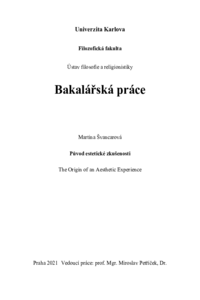Původ estetické zkušenosti
The origin of aesthetic experience
bakalářská práce (OBHÁJENO)

Zobrazit/
Trvalý odkaz
http://hdl.handle.net/20.500.11956/150584Identifikátory
SIS: 204793
Kolekce
- Kvalifikační práce [24991]
Autor
Vedoucí práce
Oponent práce
Roreitner, Robert
Fakulta / součást
Filozofická fakulta
Obor
Filozofie
Katedra / ústav / klinika
Ústav filosofie a religionistiky
Datum obhajoby
8. 9. 2021
Nakladatel
Univerzita Karlova, Filozofická fakultaJazyk
Čeština
Známka
Výborně
Klíčová slova (česky)
Estetická zkušenost|aisthesis|událost|Jean-François Lyotard|Emanuel Lévinas|matérie|neosobní bytí|úzkostKlíčová slova (anglicky)
Aesthetical experience|aisthesis|event|Jean-François Lyotard|Emanuel Lévinas|matter|impersonal being|anxietyTato práce pojednává o estetické zkušenosti u francouzských filosofů Jean- Françoise Lyotarda a Emanuela Lévinase. Oba ji rozumí jako zkušenosti smyslové, při níž se však setkáváme s nesmyslovým. V první řadě je pozornost zaměřena na Lyotardovu koncepci, je popsán koncept nemateriální matérie, gesto, jehož prostřednictvím o sobě matérie dává vědět, role umělce vůči uměleckému dílu, ale zejména hrůza a úzkost, kterou matérie vyvolává. Následně se text věnuje Lévinasovi a jeho konceptu neosobního bytí, s nímž matérii ztotožňuje, je popsán exotismus díla a za pomocí Blanchotova Temného Tomáše přiblížena podobná úzkost zakoušená v rámci této estetické události. Přístupy obou myslitelů jsou srovnávány a jsou odhalovány zásadní protiklady v jejich koncepcích (tím nejdůležitějším je odlišná příčina úzkosti, kterou v nás umělecká matérie vyvolává), což je podstatné zejména pro nápadnou podobnost obou koncepcí.
The thesis discusses an aesthetic experience according to French philosophers Jean- François Lyotard and Emanuel Lévinas. Both understand it as a sensual experience in which we are concerned with the nonsensual. I focus on the conception of Lyotard in the first place. His concept of immaterial matter is described as well as the gesture by which the matter announces itself, the role of an artist in relation to his artwork, but especially the horror and anxiety to which the matter gives rise. Then the text deals with Lévinas and his concept of impersonal being, which he identifies with the matter. Then the exotic character of artwork is described, and similar anxiety experienced within the aesthetic event is demonstrated using Blanchot's Thomas the Obscure. Approaches of both thinkers are compared and fundamental contradictions in their conceptions are revealed (the most important one is a different cause of the anxiety), which is important especially due to the striking similarity of both conceptions.
